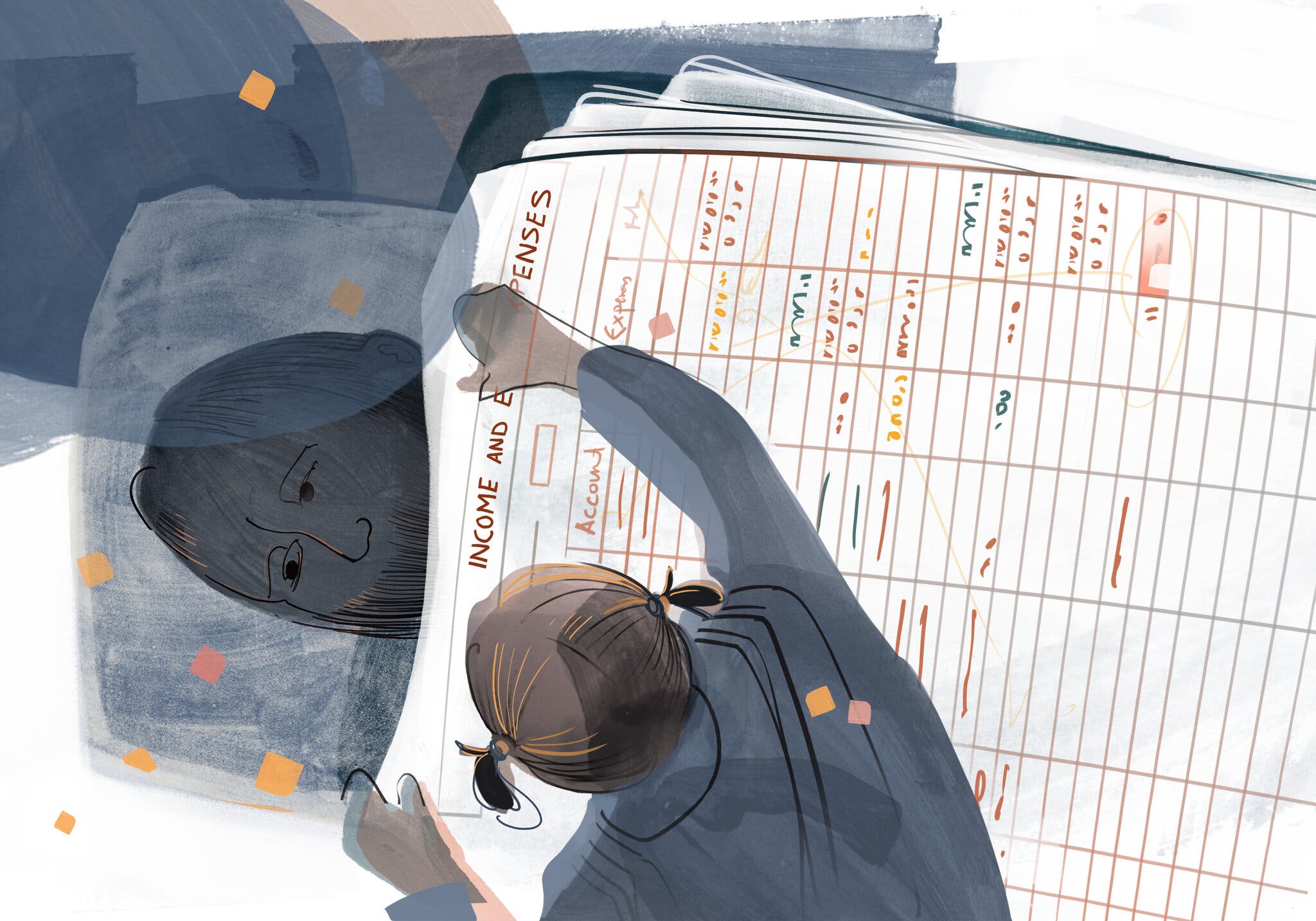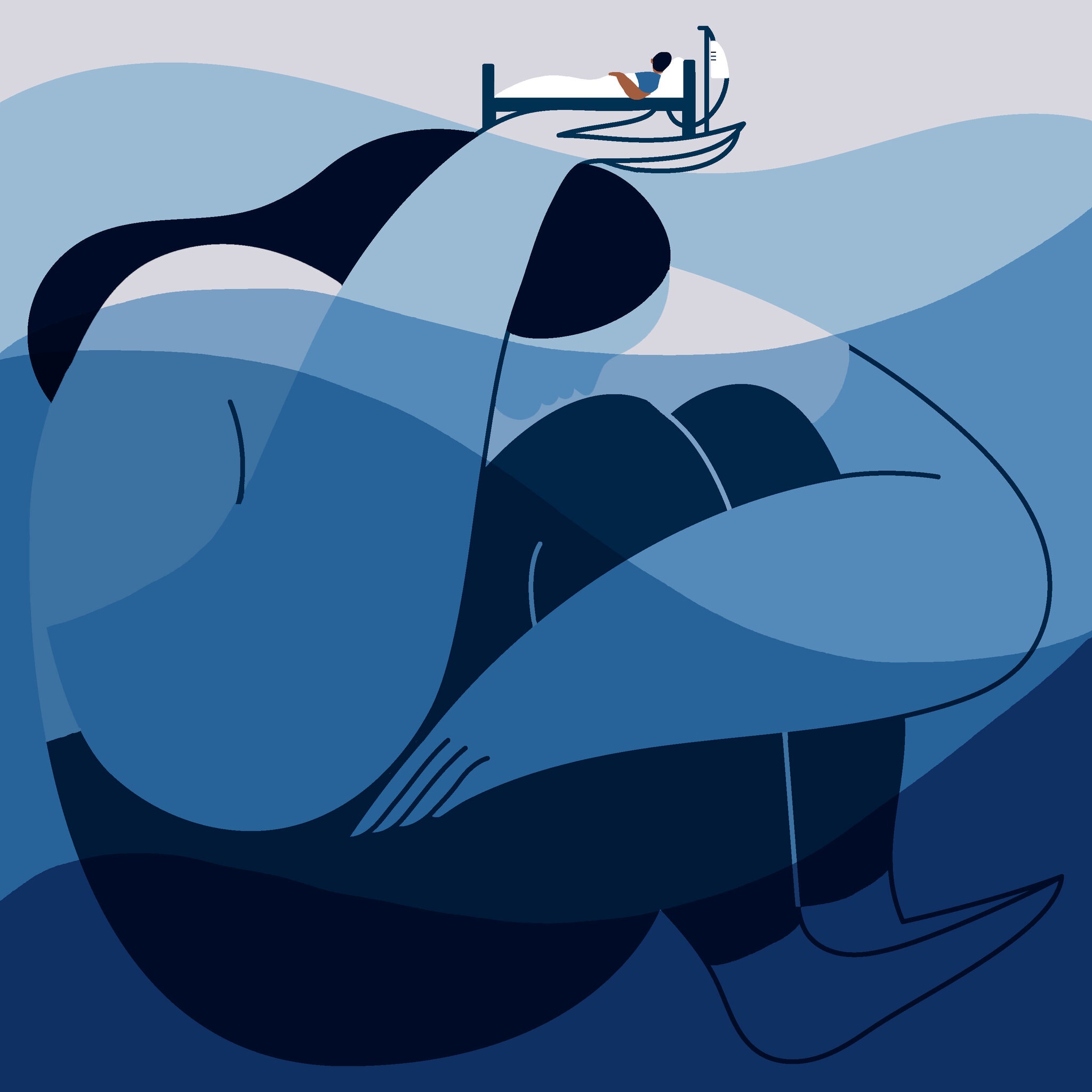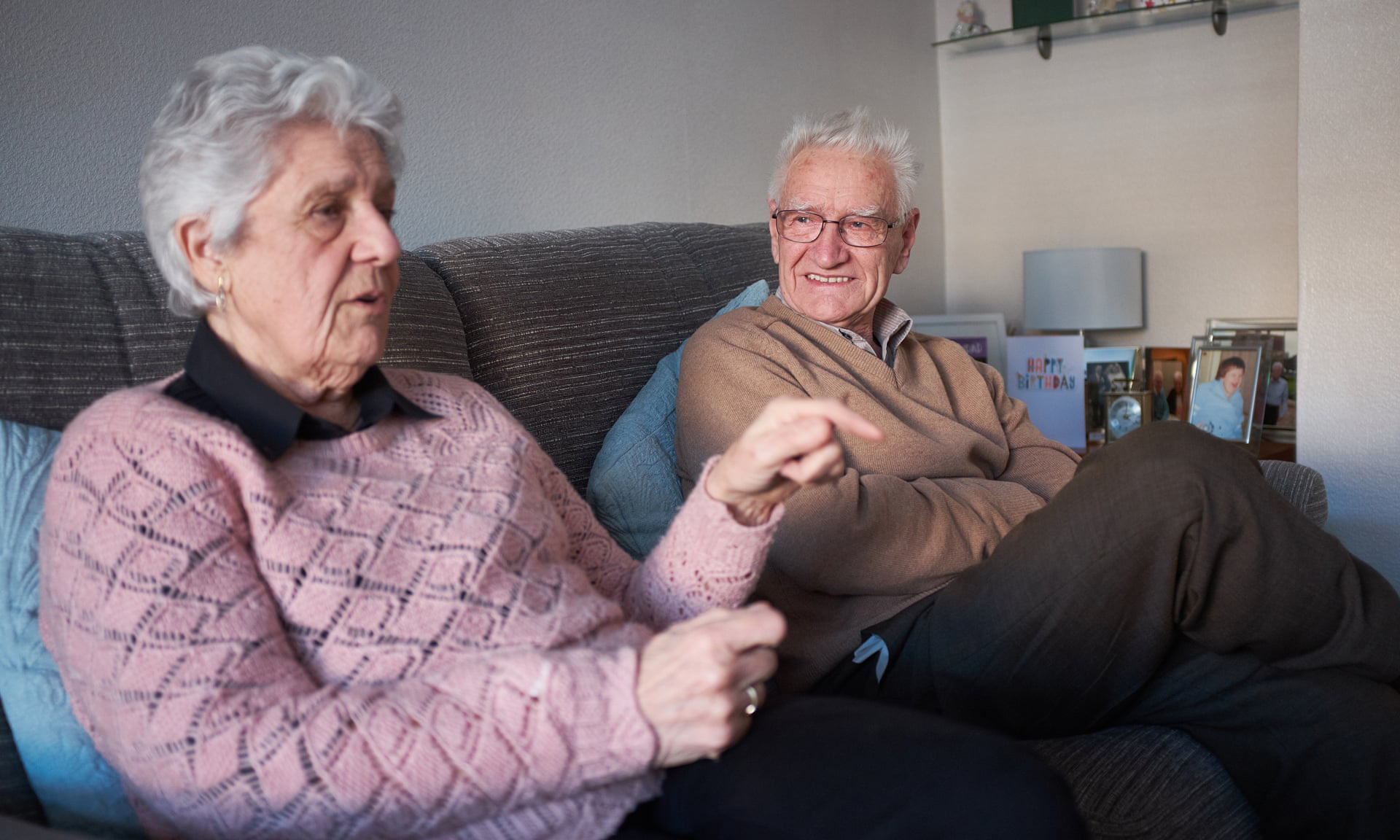|
Vocapedia >
Health > Patients > Family caregivers

Illustration: Mary Haasdyk
I Took Over My Father’s Finances
at 25.
The Lessons Were Hard-Won.
Many adult children end up caring
for their parents late in life.
But when the role reversal happens
in their 20s and 30s,
the burden can feel too much to
bear.
NYT
March 25, 2023
https://www.nytimes.com/2023/03/25/
business/young-caregivers-money-management.html

Illustration: Karolin Schnoor
The Costly, Painful, Lonely Burden of Care
Health care in the U.S. relies
on an “invisible army” of
caregivers — mostly women.
For many, stunted careers,
lost earnings and exhaustion are
part of the fallout.
NYT
March 16, 2021
https://www.nytimes.com/2021/03/16/
us/caregiving-burnout.html

Ann and
Derrick Sturdy have been carers for 53 years
to their youngest child Kay,
who was
diagnosed with microcephaly
at the age of five.
Now into
their 80s,
their day begins at 7am and ends at 10pm,
or when
Kay decides she wants to go to bed.
Ann
still does all Kay’s bathing,
dressing and laundry.
Photograph: Sara Ryan
‘Family
carers are unsung heroes’ - in pictures
For the
past three years,
Oxfordshire Family Support Network has been running a project
for
carers assisting an adult family member with learning disabilities.
Sara
Ryan’s portraits of older carers will be displayed
around
the county to coincide with Carers Week
G
Tue 11
Jun 2019 08.13 BST
https://www.theguardian.com/society/gallery/2019/jun/11/
family-carers-unsung-heroes-in-pictures
family caregivers UK
https://www.theguardian.com/society/
carers
https://www.theguardian.com/lifeandstyle/2020/dec/26/
i-expect-my-elderly-parents-to-die-but-to-suffer-alone-
the-truth-about-caring-through-covid
https://www.theguardian.com/society/2018/jul/16/
nearly-8-million-people-providing-care-for-family-members-
without-pay
https://www.theguardian.com/society/2020/jun/10/
family-carers-hidden-army-not-invisible-just-ignored
https://www.theguardian.com/books/2019/aug/21/
top-10-caregivers-in-fiction-lila-savage
https://www.theguardian.com/society/gallery/2019/jun/11/
family-carers-unsung-heroes-in-pictures
https://www.theguardian.com/society/2013/may/16/
thousands-children-caregivers-family-data
family caregivers USA
2023
https://www.nytimes.com/2023/03/25/
business/young-caregivers-money-management.html
2021
https://www.npr.org/sections/health-shots/2021/06/17/
1007579073/unpaid-caregivers-were-already-struggling-
its-only-gotten-worse-during-the-pande
https://www.nytimes.com/2021/03/16/
us/caregiving-burnout.html
https://www.nytimes.com/2021/03/02/
opinion/letters/covid-caregivers-families.html
2020
https://www.nytimes.com/2020/07/23/
upshot/biden-caregiving-plan.html
https://www.npr.org/sections/health-shots/2020/01/21/
789958067/patients-want-to-die-at-home-
but-home-hospice-care-can-be-tough-on-families
2019
https://www.nytimes.com/2019/09/18/
opinion/male-care-giver.html
https://www.nytimes.com/2019/08/29/
business/economy/labor-family-care.html
https://www.npr.org/sections/health-shots/2019/07/14/
741077294/caregiving-for-a-loved-one-how-to-get-the-help-you-need
https://www.npr.org/2019/07/11/
740715027/how-to-be-a-better-caregiver-when-a-loved-one-gets-sick
https://www.nytimes.com/2019/03/20/
well/family/states-seek-financial-relief-for-family-caregivers.html
https://www.npr.org/2019/03/16/
702698968/as-parents-and-grandparents-age-more-and-more-
millennials-are-family-caregivers
https://www.npr.org/2019/03/09/
701838946/millennial-caregivers-balance-family-and-ambition
2018
https://www.nytimes.com/2018/09/19/
well/live/when-family-members-care-for-aging-parents.html
https://www.npr.org/sections/health-shots/2018/07/06/
621110042/shared-tips-support-help-prevent-burnout-
among-alzheimers-family-caregivers
https://www.npr.org/sections/health-shots/2018/04/27/
606054065/family-caregivers-finally-get-a-break-and-some-coaching
2017
https://www.nytimes.com/2017/01/19/
upshot/who-will-care-for-the-caregivers.html
2013
https://www.npr.org/sections/health-shots/2013/10/16/
235384054/family-caregiving-can-be-stressful-rewarding-and-life-affirming
2011
https://www.npr.org/2011/07/18/
138163839/aarp-finds-toll-on-family-caregivers-is-huge
care for N
USA
https://www.nytimes.com/2019/08/29/
business/economy/labor-family-care.html
look for N
USA
https://www.nytimes.com/2020/07/23/
upshot/biden-caregiving-plan.html
Corpus of news articles
Illnesses, Diseases, Conditions > Patients
Family caregivers
The Costly, Painful, Lonely
Burden of Care
Health care in the U.S. relies on an “invisible army”
of caregivers — mostly women. For many, stunted careers, lost earnings and
exhaustion are part of the fallout.
March 16, 2021
The New York Times
By Mara Altman
“If society wants us to keep caring for others, it’s going to
have to show a little more care for us.”
— Kate Washington, the author of “Already Toast: Caregiving and Burnout in
America”
[In Her Words is available as a newsletter. Sign up here to get it delivered to
your inbox.]
In 2015, Kate Washington’s world changed. Her husband, Brad Buchanan, was late
for family dinner. She found him in the bathroom, coughing up blood — a lot of
it. She handed him a bucket and asked the neighbor to watch their two young
daughters while she drove him to the emergency room.
Doctors found that a tumor had ruptured in one of his lungs and he urgently
needed chemo. As her husband became critically ill, Ms. Washington, a freelance
writer, was thrust into the role of nurse.
After Mr. Buchanan’s first round of chemo, the tumor shrank too quickly, causing
his lung to collapse and then fill with thick, toxic fluid that put him at high
risk for infection. Before he could continue treatment for cancer, he was sent
home to recuperate.
Ms. Washington found herself performing high-level nursing tasks, like
administering antibiotics three times a day through a PICC line — a thin tube
that leads from veins in the arm to the veins near the heart. “My hands were
shaking,” she said as she remembered apprehensively pushing in the drugs for the
first time and feeling the weight of keeping her husband alive.
But that weight would only become heavier when Mr. Buchanan had a stem cell
transplant that left him with graft-versus-host disease, a condition that occurs
when donated cells attack the body.
After spending four months in the hospital, becoming temporarily blind and
unable to walk, eat, dress or use the toilet on his own, he was given his
discharge papers. A doctor told Ms. Washington that her husband would need
24-hour care and “could not be left alone for even a moment.” When she explained
that she had two children who also had needs, he said, “Well, usually family
steps in, and it works out fine.”
Ms. Washington felt the burden of responsibility, but also the sting: The U.S.
health care system relies on and takes for granted the “invisible army” of
people — mostly women — who keep the system functioning by performing home care
for the many people who are “too well for the hospital” but “too sick for home,”
as well as for those on end-of-life care.
In 2017, AARP found that about 41 million family caregivers in America perform
roughly $470 billion worth of unpaid labor a year. Since then, the number of
caregivers has increased to 53 million, meaning that more than one out of five
Americans are caregivers, according to AARP’s latest report.
Depending on the analysis, between 61 and 75 percent of caregivers are women,
and they tend to do more personal care tasks like helping patients bathe and use
the toilet than their male counterparts, who are more likely to oversee finances
and arrangement of care.
Female caregivers put in more hours — 22 to men’s 17 — and they are also more
likely to stand by their partner through a serious illness. According to a study
in the journal Cancer, women living with brain tumors or multiple sclerosis were
seven times as likely to be abandoned by their spouses as men with similar
diseases.
Many people who take on caregiving roles experience negative health impacts, but
women are especially at risk of the fallout from caregiver stress. Female
caregivers are also 2.5 times more likely to live in poverty as non-caregivers,
with many leaving the work force to do care work. A 2011 study found that women
who left their jobs to care for a parent lost an average of $324,000 in wages
and benefits over their lifetimes.
Ms. Washington was able to dip into savings and a recent inheritance to help pay
for supplemental in-home care, but it was still a struggle, causing stress,
resentment and lost income.
Her book, “Already Toast: Caregiving and Burnout in America,” published by
Beacon Press and on shelves this week, details the day-to-day challenges of
caring for a partner with severe illness, but it also examines how the health
care system must change to better support caregivers. “If society wants us to
keep caring for others,” she writes, “it’s going to have to show a little more
care for us.”
In Her Words spoke with Ms. Washington over phone and email. The conversation
has been edited for length and clarity.
If we go with the metaphor that cancer is a battle, then you call yourself
“collateral damage.” Explain.
I was compelled to enter this new life where the center of it was caring for
someone else, and even though I love that person very much, it was a hard loss.
It was hard to have my life put on hold. Everything kind of slipped away.
As you became “collateral damage,” what was lost?
I lost a sense of who I was. I was going to pick up a prescription for myself,
the only prescription I had when my husband was sick, and the pharmacist asked
for my date of birth, and I gave his date of birth. I was so used to picking up
things for him, I spaced on the fact that I also had needs. For a few years, I
essentially stopped having a professional life. There was this feeling of
erasure — that my needs and desires were no longer important.
What was the fallout of not feeling seen for so long?
I got angry. That sense of being unseen became literal because Brad had lost his
vision, which is not to blame him for that at all, but it made a metaphor an
actual, concrete thing. The things I was doing for him were being taken for
granted or were invisible to him. That started to create resentment. I wanted to
be acknowledged for how much I was giving up of the life I normally would have
been leading.
What could have helped you feel acknowledged?
A culture shift to valuing care isn’t really a quick fix exactly, but that would
be nice. From the medical establishment? Not taking at-home care for granted.
There is also a longstanding gender stereotype that women are the caring sex.
There’s a lot of pressure on women to conform to and stick with these roles and
to not raise their voices about all the difficulties they face. Just because
women are expected to do the caring, doesn’t mean it comes easier to them.
You express in your book that a disservice to caregivers is equally a disservice
to those receiving the care. Can you explain this idea?
If there is too much responsibility on caregivers, the patient can suffer.
Burnout can undermine the sense of empathy, the sense of love and the sense of
providing good care.
This can impact practical outcomes, like how quickly the person can recover, but
it can also be damaging for the relationship between caregiver and the recipient
of care, which is less quantifiable, but also hard to contend with.
There was a powerful quote in your book from Evelyn Nakano Glenn’s “Forced to
Care.” She wrote that our society views family caregiving as both “priceless and
worthless.”
There is a narrative that the caregiving work we do is invaluable and the gift
of caring is its own reward, but the flip side of something being priceless is
that you paradoxically strip it of all its value. It’s so valuable that we can’t
put a monetary price on it, which then takes away the economic worth.
People talk about how it’s the most important job in the world, taking care of
our children or taking care of our vulnerable elders, and yet those are some of
the worst paid jobs. How much is a quarterback paid versus someone who is doing
care for a vulnerable elderly person?
How did care work become so undervalued?
The historical roots are complex, but as Evelyn Glenn puts it in “Forced to
Care,” Western culture has long framed care work done by women as a moral duty
or obligation, rather than an economic activity.
Whereas in preindustrial times, women’s domestic work was understood to
contribute to a household financially, the Victorian era saw a gendered split
between the domestic sphere and the economically productive public sphere.
Family caregiving fell into the realm of women’s work and — like child care and
other domestic labor — became economically invisible and not counted in GDP. In
turn, the association between care and women’s free or compelled labor has
produced stigma and low wages for professional care work — a vicious circle of
devaluing.
You write that taking on the role of unpaid caregiver, a role that often isn’t a
choice, can have generational impacts. Explain.
If your earnings are lower than they would normally be because you’re busy
caring for a family member, and you can’t save and pay into social security, it
can lock whole families into a cycle of lower wealth and economic instability.
How can people best help their caregiver friends and neighbors?
There is a reason that taking people a meal is a classic, because it is super
helpful. If you do that, always bring disposable containers so that the person
does not have to return them. Offering to help with errands or with child care
is great, and if the situation permits, offer to sit with and stay connected to
the person who is ill. When Brad could be more in touch with his community, it
eased some of the pressure on me.
And what should someone not do?
Don’t tell someone to stay positive. For me, there was no staying about it,
because I didn’t feel positive to start with. It brought up this feeling: My
time isn’t my own, but surely my emotions can be.
The Costly, Painful, Lonely Burden of Care,
March 16, 2021,
NYT,
https://www.nytimes.com/2021/03/16/
us/caregiving-burnout.html
Explore more on these topics
Anglonautes > Vocapedia
patients
patients > pain
hospital > nurses
body,
health, medicine, drugs,
viruses, bacteria,
diseases / illnesses,
hygiene, sanitation,
health care / insurance
health > disabilities
health,
contraception, abortion,
pregnancy, birth, life,
life expectancy,
getting older / aging,
death
health > cells, DNA,
genes, genetics, gene editing
mental health > stress, burnout
mental health, psychology
compassion, empathy, empaths
lifestyle, health > food >
junk food, healthy food, diet,
veganism, vegetarianism
lifestyle, health >
exercise,
smoking / tobacco, vaping,
drinking / alcohol,
diet, obesity
|